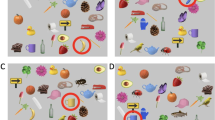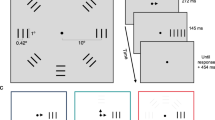The aim of the present work was to assess the range of angular sizes of fragmented images of objects at which perception of the images was scale-independent. Measurements were made of human subjects’ recognition thresholds for the shapes of the objects over a wide range of angular sizes (0.19–50°). The experiments used the Gollin test – a method for studying the recognition of fragmented outline images of objects with which the observer is familiar. The results obtained demonstrated that there is a wide range of angular sizes, from 1.0° to 50°, over which the perception thresholds of incomplete outline images do not change with changes in size, along with a narrow range of stimulus sizes, 0.19–1.0°, over which there is a significant size dependence. We suggest that the increase in thresholds and the failure to recognize images of small size occur as a result of an increased contribution of sampling noise at the level of the human retina.
Similar content being viewed by others
References
V. V. Aleksandrov and N. D. Gorskii, Image Representation and Processing. A Recursive Approach [in Russian], Nauka, Leningrad (1985).
V. D. Glezer, K. N. Dudkin, and N. F. Podvigin, Visual Recognition and its Neurophysiological Mechanisms [in Russian], Nauka, Leningrad (1975).
V. D. Glezer and I. I. Tsukkerman, Information and Vision [in Russian], Academy of Sciences of the USSR Press, Moscow, Leningrad (1961).
F. V. Campbell and Yu. E. Shelepin, “Foveolar object discrimination ability,” Sensor. Sistemy, 4, No. 2, 181–185 (1990).
A. V. Merkul’ev, Yu. E. Shelepin, V. N. Chikhman, S. V. Pronin, and N. Foreman, “Optical geometrical characteristics and perception thresholds for fragmented outline figures,” Ros. Fiziol. Zh. im. I. M. Sechenova, 89, No. 6, 731–737 (2003).
A. V. Merkul’ev, S. V. Pronin, L. A. Semenov, N. Foreman,V. N. Chikhman, and Yu. E. Shelepin, “Threshold signal:noise ratios for the perception of fragmented figures,” Ros. Fiziol. Zh. im. I. M. Sechenova, 90, No. 11, 1348–1355 (2004).
N. Stefanova, “The invariance of visual images,” in: Second National Conference of the Bulgarian Physiology Society, Sofia (97), (1964), p. 19.
N. Stefanova, “Importance of size in the process of recognition of visual objects,” in: Studies of the Principles of the Information Processing in the Visual System [in Russian], Leningrad (1970).
Yu. E. Shelepin, “Localization of areas in the visual cortex of kittens giving invariant responses to changes in image size,” Neirofiziologiya, 5, No. 2, 115–121 (1973).
Yu. E. Shelepin, “Comparison of topographic and spatial-frequency characteristics of the lateral suprasylvian and striate areas of the cortex in cats,” Neirofiziologiya, 16, No. 1, 35–41 (1984).
Yu. E. Shelepin, V. M. Bondarko, and M. V. Danilova, “Construction of foveola and a model of the pyramidal organization of the visual system,” Sensor. Sistemy, 9, No. 1, 87–97 (1995).
I. Biederman and E. E. Cooper, “Evidence for complete translational and reflectional invariance in visual object priming,” Perception, 20, 585–593 (1991).
D. Bohm, “Physics and perception. The role of invariants in perception,” in: The Special Theory of Relativity [Russian translation], Mir, Moscow (1967), pp. 239–281, originally published by Benjamin Inc., New York (1965).
P. Burt and E. Adelson, “The laplacian pyramid as a compact image code,” IEEE Transactions on Communications, Com-31, 4 (1983).
V. Canton and A. Petrosino, “Neural recognition in a pyramidal structure,” IEEE Transactions on Neural Networks, 13, No. 2, (2002).
P. Cavanagh, “Size and position invariance in the visual system,” Perception, 7, 167–177 (1978).
V. Chikhman,Y. Shelepin, N. Foreman, A. Merkuljev, and S. Pronin, “Incomplete figure perception and invisible masking,” Perception, 35, No. 11, 1441–1457 (2006).
B. M. Dow, A. Z. Snyder, and R. G. Vautin, “Magnification factor and receptive field size in foveal striate cortex of the monkey,” Exptl. Brain Res., 44, 213–228 (1981).
J. Fiser and I. Biederman, “Size invariance in visual object priming of gray-scale images,” Perception, 24, No. 7, 741–748 (1995).
D. Fize, W. Vanduffel, and K. Nelissen, “The retinotopic organization of primate dorsal V4 and surrounding areas: A functional magnetic resonance imaging study in awake monkeys,” J. Neurosci., 23, No. 19, 7395–7406 (2003).
N. Foreman, “Correlates of performance on the Gollin and Mooney tests of visual closure,” J. Gen. Psychol., 118, No. 1, 13–20 (1991).
N. Foreman and R. Hemming, “The gollin incomplete figures test: a flexible, computerized version,” Perception, 16, 543–548 (1987).
W. Gerbino and C. Fantoni, “Visual interpolation is not scale invariant,” Vision Res., 46, No. 19, 3142–3159 (2006).
E. S. Gollin, “Developmental studies of visual recognition of incomplete object,” Perceptual Motor Skills, 11, 289–298 (1960).
D. H. Hubel and T. N. Wiesel, “Uniformity of monkey striate cortex: A parallel relationship between field size, scatter and magnification factor,” J. Comp. Neurol., 158, No. 3, 295–306 (1974).
D. G. Lowe, “Distinctive image features from scale-invariant key points,” IJCV, 60, No. 2, 91–110 (2004).
C. Mehanian and S. Rak, “Bidirectional log-polar mapping for invariant object recognition,” SPIE, 1471, 200 (1991).
T. M. Murphy and L. H. Finkel, “Shape representation by a network of V4-like cells,” Neural Networks, 20, No. 8, 851–867 (2007).
M. B. Patterson, J. L. Mack, and A. H. Schnell, “Performance of elderly and young normals on the Gollin Incomplete Pictures Test,” Perceptual Motor Skills, 89, No. 2, 663–664 (1999).
J. R. Polimeni, M. Balasubramanian, and E. L. Schwartz, “Multiarea visuotopic map complexes in macaque striate and extra-striate cortex,” Vision Res., 46, No. 20, 3336–3359 (2006).
J. Ross, B. Jenkins, and J. R. Johnstone, “Size constancy fails below half a degree,” Nature, 283, No. 5746, 473–474 (1980).
E. L. Schwartz, “Computational anatomy and functional architecture of striate cortex: a spatial mapping approach to perceptual coding,” Vision Res., 20, 645–669 (1980).
E. L. Schwartz, “Cortical mapping and perceptual invariance: a reply to Cavanagh,” Vision Res., 23, No. 8, 831–835 (1983).
M. Singh and J. Fulvio, “Bayesian contour extrapolation: Geometric determinations of good continuation,” Vision Res., 47, 783–798 (2007).
K. Srinivas, “Size and reflection effects in priming: a test of transfer appropriate processing,” Memory Cognition, 24, 441–452 (1996).
N. Stefanova, “Effects of the angle of rotation of visual objects on recognition in a time-deficit situation,” in: Visual Information Processing, Sofia (1974), pp. 109–114.
N. S. Sutherland, “Theories of shape discrimination in octopus,” Nature, 186, 840 (1960).
N. S. Sutherland, “Outlines of a theory of visual pattern recognition in animals and man,” Proc. Roy. Soc. Lond., B171, 297–317 (1968).
C. F. R. Weiman, “Log-polar vision for mobile robot navigation,” Conference Proceedings “Electronic Imaging,” 90, 382–385 (1990).
J. R. Wilson and S. M. Sherman, “Receptive-field characteristics of neurons in cat striate cortex: Changes with visual field eccentricity,” J. Neurophysiol., 39, No. 3, 512–533 (1976).
S. Zokai and G. Wolberg, “Image registration using log-polar mapping for recovery of large-scale similarity and projective transformations,” Image Processing. IEEE Transactions, 14, No. 10, 1422–1434 (2005).
Author information
Authors and Affiliations
Corresponding author
Additional information
Translated from Rossiiskii Fiziologicheskii Zhurnal imeni I. M. Sechenova, Vol. 94, No. 10, pp. 1158–1170, October, 2008.
Rights and permissions
About this article
Cite this article
Vakhrameeva, O.A., Shelepin, Y.E., Mezentsev, A.Y. et al. Studies of the Perception of Incomplete Outline Images of Different Sizes. Neurosci Behav Physi 39, 841–849 (2009). https://doi.org/10.1007/s11055-009-9209-4
Received:
Revised:
Published:
Issue Date:
DOI: https://doi.org/10.1007/s11055-009-9209-4




